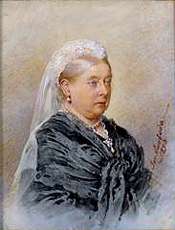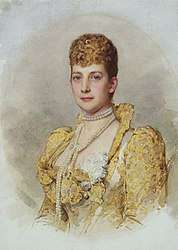Josefine Swoboda
Josefine Swoboda (29 January 1861 in Vienna – 27 October 1924 in Vienna) was an Austrian portrait painter. She was one of the most active Vienna portraitists.
Josefine Swoboda | |
|---|---|
| Born | 29 January 1861 |
| Died | 27 October 1924 (aged 63) |
| Occupation | Portrait painter |
Life

by Josefine Swoboda
(watercolor, 1893)

by Josefine Swoboda
(watercolor, 1895)
Josefine Swoboda came from a Vienna family of artists, she was the daughter of the portrait painter Eduard Swoboda (1814-1902) and his second wife Josefine (née Müller; 1839-1906), and sister of the painter Rudolf Swoboda the younger (1859-1914). Her uncles were the landscape and animal painter Rudolf Swoboda the elder (1819-1859) and the orientalist Leopold Carl Müller (1834-1892). After her first painting lessons with her father she studied from 1878 to 1886 as a listener at the k.k. Kunstgewerbeschule which was closely associated with the Österreichisches Museum für Kunst und Industrie (Imperial Royal Austrian Museum of Art and Industry), among others under Ferdinand Laufberger and Julius Victor Berger.
Constantin von Wurzbach wrote in his Biographical Encyclopedia of the Empire of Austria in 1880 about her: "Her excellent work find rapid sale and the only 19-year-old artist entitled to the most beautiful hopes."[1]
Josefine Swoboda's works were mainly watercolors, mostly portraits and (less) genre scenes and still life. From 1886 she was regularly represented in the Vienna Künstlerhaus and participated in exhibitions in Hamburg (1887), Munich and Berlin (1888). Pictures of her were also exhibited at the 1893 Chicago World Exposition. Probably on the recommendation of her brother and Heinrich von Angeli, who worked for the British royal house as a painter, she received the title of court painter of Queen Victoria in 1890. With interruptions and usually only during the summertime she was in England until 1899, portraying the royal family and persons of the court in numerous watercolors. Her paintings are still today in the Royal Collection at Windsor Castle.
Josefine Swoboda also received numerous orders from the Austrian imperial house around Franz Joseph I[2] and other noble houses, which made her to one of the most active Vienna portraitists. From 1902 she was represented in the "Salon Pisko" by the "Gruppe der 8 Künstlerinnen" in their exhibitions "Acht Künstlerinnen und ihre Gäste" (Eight female artists and their guests).[3] Some of her works are in the Vienna Museum as well as in the graphic collection of the Albertina in Vienna. From 1886 she became a member of the "Künstlerhaus", the "Austrian (fine art) Artists' Society" .[4]
Further reading
- Zemen, Herbert (2004): Die Porträtmalerin Josefine Swoboda. 1861–1924. Leben und Werk. Vienna. (in German)
- Ulrich Thieme, Felix Becker at all (1938). Allgemeines Lexikon der Bildenden Künstler von der Antike bis zur Gegenwart (in German). Vol. 32. E. A. Seemann, Leipzig. p. 355.
- Ch. Gruber: "Swoboda, Josefine (1861–1929)". In: Österreichisches Biographisches Lexikon 1815–1950 (ÖBL). Vol. 14, Austrian Academy of Sciences, Vienna 1957–2005, p. 87 f. (Direct links to "p. 87", "p. 88")
- Constantin von Wurzbach (1880). Biographisches Lexikon des Kaiserthums Oesterreich [Biographical dictionary of the Austrian Empire] (in German). Theil. 41. Kaiserlich-königliche Hof- und Staatsdruckerei, Wien. p. 84. (Direct link to "p. 84")
References
- Constantin von Wurzbach: Biographisches Lexikon des Kaiserthums Oesterreich. vol. 41, p. 84 (See further reading) "Ihre trefflichen Arbeiten finden rasche Abnahme und die erst 19jährige Künstlerin berechtigt zu den schönsten Hoffnungen."
- Srnka, Elise (23 August 1930). "Kaiser Franz Josefs letzte Porträt-Sitzung". ANNO - Austrian newspaper online (in German). Baden/Vienna: Badener Zeitung. p. 1. Retrieved 20 October 2016.
PDF
("Emperor Franz Josef's last portrait session") - "Acht Künstlerinnen und ihre Gäste". ANNO - Austrian newspaper online (in German). Vienna: Neues Frauenleben. January 1902. p. 15. Retrieved 20 October 2016.
PDF
- "Das Künstlerhaus – 6. Mitglieder – Mitglieder-Gesamtverzeichnis" (in German). Wladimir-Aichelburg.at. Retrieved 20 October 2016.
External links
| Wikimedia Commons has media related to Josefine Swoboda. |
- Some pictures at the Royal Collection: A search at the Royal Collection Trust, retrieved 20 October 2016.
- Some Works of Josefine Swoboda at Artnet